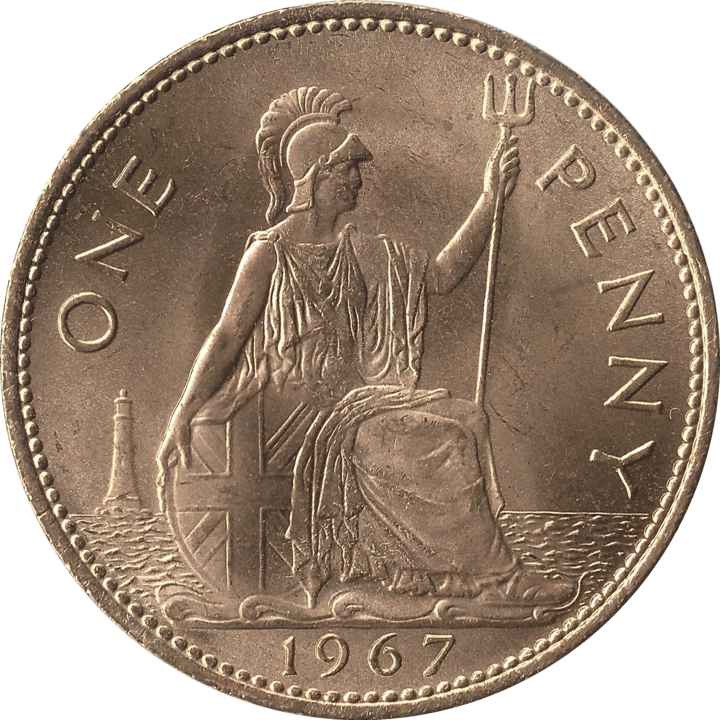
When was the penny first used? The first coin to be called a penny was in 790, but the word meant “all money” and not just one coin.
There are several currencies across the world that use “penny” for their smallest coin. In the UK there is a one penny coin. In the United States and Canada, the one cent coin is known as a penny. (Although Canada has stopped minting them because pennies cost more to make than they are worth.) The penny started in the UK and it was the currency in Canada and the United States before they took up the dollar. Before the UK decimalized its currency in 1971, the currency was based on pounds, shillings, and pence. One shilling was worth 12 pennies. 1 pound was worth 240 pennies. This was the system that was originally used in the United States and Canada.
So, when was the penny first used? We have to head back to Roman times to examine this question. When the Roman Empire conquered Europe, they took their currency with them. The money used throughout the Roman Empire from 211 BC to about 244 AD was the denarius. It comes from the Latin word “deni”, which means “containing ten” because 1 denarius was worth 10 asses. An asses was a bronze coin. Because the denarius was the main currency throughout most of Europe, the word for money in many languages is connected to denarius. In Italian it is denaro, in Portuguese it is dinheiro, in Slovene it is denar, and in Spanish it is dinero.
When the Roman Empire fell and the Romans withdrew, they took their money with them, but many of their names for things had become ingrained. After the Romans had gone, England had to start making their own coins and they called them denarius for a while. That is why the symbol for a penny is d and not p.
After the Romans were gone, the gold solidus was the money that was used throughout Europe. All trade and debts were counted in solidus.
In about AD 755, Pepin the Short, the father of Charlemagne and King of the Franks introduced a currency reform. He wanted to standardize the amount of precious metal in coins. He decided that 1 denier (the name coming from denarius) should weigh 1/240th of a pound of silver. This established the monetary system that would be used in Europe. It is also the reason why the pound is the currency of England. It was literally a pound of weight. 240 denier (pennies) were 1 pound in weight. The silver coins were less popular than the gold solidus because gold was worth more than silver. The problem was, most people couldn’t afford gold coins. This was basically the end of gold coins.
In about 790. Offa, King of Mercia introduced these coins to England. The coin was made of 22.5 grains of silver. The coin was probably called a penig, but the word meant all coins because there were no other coins. The weight was kept the same so that there were still 240 coins in a pound of silver. Penigs were counted using shillings and pounds. The word shilling was taken from the gold solidus that had been used. There were 12 penigs in a shilling and 240 penigs in a pound, but shillings and pounds weren’t coins themselves, they were just terms for counting penigs. The only coins in circulation were the penigs. There were different designs, but only the one coin.
The word penig comes from a root word somewhere in northern Europe because all Germanic languages use similar words for their coins. The pfennig was used in Germany. One idea is that the route of the word is pan because the coins were minted in a pan.
For 500 years after it was introduced, the penny was the only coin in England. In 1257, Henry III tried to reintroduce gold coins. Merchants couldn’t do trade only in pennies because they would have to use too many of them. They got around this by using gold coins from Arabia or the Byzantine Empire. Henry III didn’t like this, so he introduced a gold penny that was worth 20 pence. They were not popular but, more than that, it turned out the coins contained 24 pence worth of gold, so most of them were melted down for profit. In 1279, Edward I introduced a coin called a groat that was worth four pence.
By the early 18th century, the royal mint was running out of silver. They couldn’t produce silver pennies every year. In 1787 the first copper pennies were struck. Matthew Bolton got the contract to make pennies and he used steam power to produce millions of coins.
So, when was the penny first used? It started out as a replacement for the Roman denarius and meant “coin” for most of its existence. In England, it was made of silver and there were 240 pennies in a pound of silver. The coins became copper in the late 18th century. And this is what I learned today.
Sources
https://www.etymonline.com/word/penny
https://www.chards.co.uk/blog/the-penny-story/375
http://www.coins-of-the-uk.co.uk/penny.html
https://en.wikipedia.org/wiki/Penny
https://en.wikipedia.org/wiki/Denarius
https://en.wikipedia.org/wiki/Gold_penny
https://en.wikipedia.org/wiki/History_of_the_British_penny_(1714%E2%80%931901)
